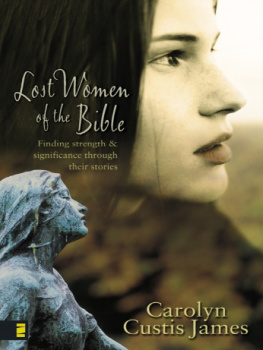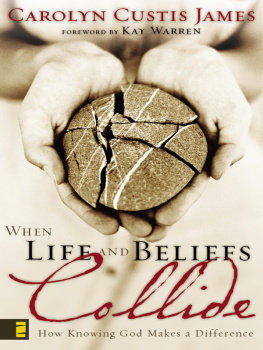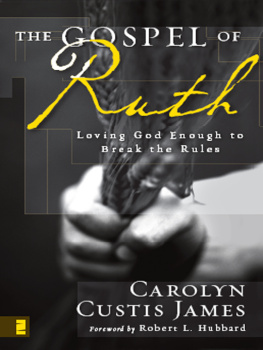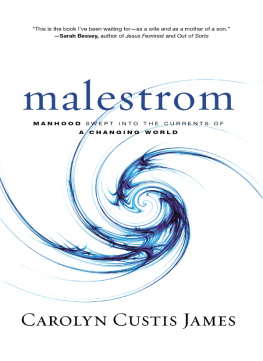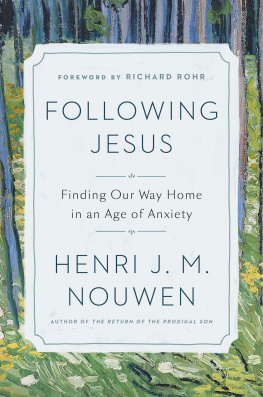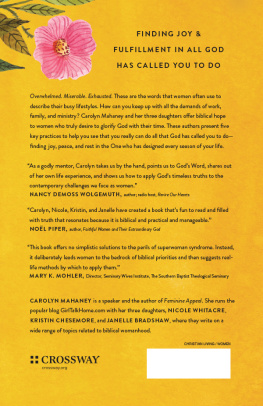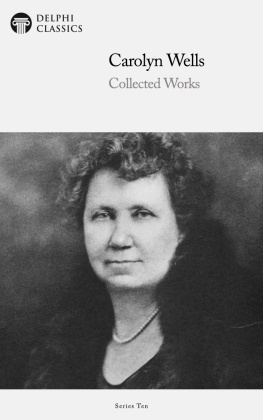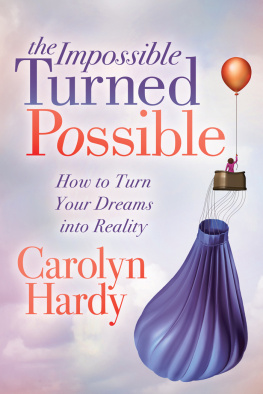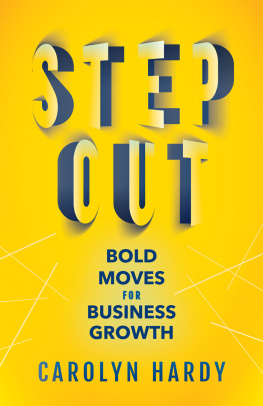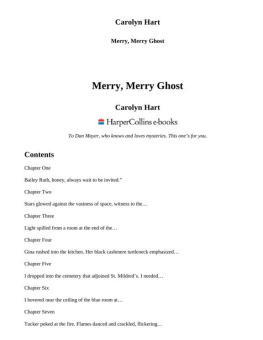Carolyn Custis James - Finding God in the Margins: The Book of Ruth
Here you can read online Carolyn Custis James - Finding God in the Margins: The Book of Ruth full text of the book (entire story) in english for free. Download pdf and epub, get meaning, cover and reviews about this ebook. year: 2018, publisher: Lexham Press, genre: Science fiction. Description of the work, (preface) as well as reviews are available. Best literature library LitArk.com created for fans of good reading and offers a wide selection of genres:
Romance novel
Science fiction
Adventure
Detective
Science
History
Home and family
Prose
Art
Politics
Computer
Non-fiction
Religion
Business
Children
Humor
Choose a favorite category and find really read worthwhile books. Enjoy immersion in the world of imagination, feel the emotions of the characters or learn something new for yourself, make an fascinating discovery.
- Book:Finding God in the Margins: The Book of Ruth
- Author:
- Publisher:Lexham Press
- Genre:
- Year:2018
- Rating:4 / 5
- Favourites:Add to favourites
- Your mark:
- 80
- 1
- 2
- 3
- 4
- 5
Finding God in the Margins: The Book of Ruth: summary, description and annotation
We offer to read an annotation, description, summary or preface (depends on what the author of the book "Finding God in the Margins: The Book of Ruth" wrote himself). If you haven't found the necessary information about the book — write in the comments, we will try to find it.
Carolyn Custis James: author's other books
Who wrote Finding God in the Margins: The Book of Ruth? Find out the surname, the name of the author of the book and a list of all author's works by series.
Finding God in the Margins: The Book of Ruth — read online for free the complete book (whole text) full work
Below is the text of the book, divided by pages. System saving the place of the last page read, allows you to conveniently read the book "Finding God in the Margins: The Book of Ruth" online for free, without having to search again every time where you left off. Put a bookmark, and you can go to the page where you finished reading at any time.
Font size:
Interval:
Bookmark:

FINDING GOD IN THE MARGINS
THE BOOK OF RUTH
TRANSFORMATIVE WORD
CAROLYN CUSTIS JAMES
Series Editor
Craig G. Bartholomew


Finding God in the Margins: The Book of Ruth
Transformative Word
Copyright 2018 Carolyn Custis James
Lexham Press, 1313 Commercial St., Bellingham, WA 98225
LexhamPress.com
St. Georges Centre
4691 Palladium Way, Burlington, ON L7M 0W9, Canada
stgeorgesonline.com/centre/
All rights reserved. You may use brief quotations from this resource in presentations, articles, and books. For all other uses, please write Lexham Press for permission. Email us at .
Unless otherwise noted, Scripture quotations are the New International Version, 2011. Used by permission. All rights reserved.
Print: 9781683590804
Digital: 9781683590811
Lexham Editorial Team: Douglas Mangum, Claire Brubaker, and
Danielle Thevenaz
Cover Design: Brittany Schrock
TABLE OF CONTENTS
One of the biggest fears in todays world is that something as harmless looking as a backpack will slip undetected through security checks, past bomb-sniffing dogs, and into a crowded area, where it will explode.
That fear became realitytwiceon April 15, 2013 , in Boston. On that fateful day during the Boston Marathon, two brothers deposited backpacks 210 feet apart near the finish line in the midst of a preoccupied, cheering crowd. The backpacks contained pressure cookers packed with deadly explosive material that, as planned, exploded sequentially in two devastating blasts.
For Boston, nothing will ever be the same.
Ironically, though the aim of that life-altering attack was to terrorize and disable the community, in the aftermath Bostonians came together. Instead of being paralyzed by fear, the rallying cry resounding in a packed Fenway Park, on Boston city streets, and echoing defiantly round the world was Boston Strong!
Overview
It may seem odd to compare the Old Testament book of Ruth to a backpack containing powerful explosives, but for far too long the Christian church has underestimated the potency of this harmless looking ancient narrative.
Traditional interpretations see the book of Ruth as a beautiful love story between the impoverished Moabitess for whom the book is named and Boaz, the wealthy Israelite landowner. Its the kind of story that is suitable for bedtime readingnot to make it hard to sleep at night. The romance interpretation is understandable, given that the story line focuses on the fortuitous meeting between a man (Boaz) and a woman (Ruth). But this is not a Disney movie.
A series of tragic events that befall Ruths mother-in-law, Naomi and push both Naomi and Ruth over the poverty line serve to draw Boaz and Ruth together. Their meeting ultimately leads to a marriage proposal (unexpectedly coming from Ruth), a wedding, the birth of a son, and, so it seems, to the restoration of the distraught Naomis spirits. According to this interpretation, the biblical camera settles on Boaz as the hero of the storya man possessed of wealth, resources, and generosity that reverse the sagging fortunes of the two women.
The story line is all too familiarseen in countless fairytales and chick flicks (with the possible exception that the man in question usually makes the proposal). The problem comes with preaching a story that has a happily-ever-after banner waving over the ending to a congregation living in real-world stories that dont play out like that. Subsequently, the book of Ruth becomes a source of pleasure but doesnt give the readers faith much substance to grasp.
Naomis losses are catastrophic and pivotal to the story. As we will see, according to ancient patriarchal calculations, Naomis losses amount to total devastation and raise disturbing questions about Gods character that the story will address. The opening five verses describe a devastating litany of tragedies that leave the Israelite Naomi emptied of everything that gave her life meaning.
Parallels between the book of Ruth and the book of Job are striking and further corroborate this interpretation. Both sufferers losses are catastrophic. Job loses his livestock, servants, children, and his health. Naomi endures famine, the life of a refugee, and the deaths of her husband and both her sons (Job 1:132:10; Ruth 1:15). It is a total wipeout for both sufferers, the only difference being that Job, as a man in a patriarchal culture, can eventually begin again. Not so Naomi, who, as a postmenopausal widow, is finished.
Both sufferers turn their attention away from secondary causes to YHWH and cry out in protest over the injustices involved in the suffering that God has unleashed on them (Ruth 1:13b, 2021; Job 6:4; 7:11). Job questions Gods justice; Naomi doubts his love ( hesed ). That one word lies at the heart of this story and is the driving force of the action that takes place. (More about that later.) Both are met by friends who find the toll of sorrow has rendered these sufferers unrecognizable (Ruth 1:19; Job 2:1113). And although in both stories God responds to each in ways that fortify their faith in him in powerful ways, he doesnt explain the reasons behind their losses.
Where the book of Ruth lands in the Bible is significant. In the Jewish Bible, the book of Ruth is located after the book of Proverbs as a beautiful example of wisdom living, a.k.a. living in the fear of God. In the Christian Bible, Ruth follows the book of Judges and precedes 1 Samuel. Viewed at the macro level, this narrative forms a sturdy bridge between the years when the judges ruled (Ruth 1:1) and the monarchy of King David (4:1822). At the micro level the story centers on urgent family issues and Ruths reinterpretation of three Mosaic laws: gleaning, levirate, and kinsman-redeemer. Ruth lives on the hungry side of the law, so her perspective differs dramatically from Boazs. His willingness to listen to her (which is one of the jaw-dropping aspects of this story) moves him from the letter to the spirit of the law. As a result, a hungry widow is fed, and a dying family is rescued.
The original readers of the book of Ruth and people living at that time would notice what is happening in this story at both macro and micro levels. But a third, cosmic level is only recognizable from the vantage point of the New Testament and beyond, for God is working through the lives of ordinary and socially insignificant individuals to advance his purposes for the world.
Framing the book of Ruth as a Job story brings this ancient narrative into the twenty-first century . Suddenly this is a story about the real world in which we live, where trouble often strikes unexpectedly and the God who has the power to prevent our sorrows doesnt stop it. Naomi is voicing questions that come to us all. Suddenly her story and her questions belong to us too. We have a stake in how the book of Ruth plays out. The story that followsthe bold initiatives of Ruth and the astonishing responses of Boazwill take us into uncharted territory, where this harmless looking little story, like the red pill in the Matrix, will awaken us to a whole new world and a whole new way of being human that will reconfigure our lives and leave us longing for more. It will raise the bar for what it means to live in a fallen world as Gods childas his image bearers. It presents a startling vision of the kingdom potency of male/female relationships and will inject rich hope, purpose, and significance into the veins of the most God-forsaken, hollowed-out human soul.
Font size:
Interval:
Bookmark:
Similar books «Finding God in the Margins: The Book of Ruth»
Look at similar books to Finding God in the Margins: The Book of Ruth. We have selected literature similar in name and meaning in the hope of providing readers with more options to find new, interesting, not yet read works.
Discussion, reviews of the book Finding God in the Margins: The Book of Ruth and just readers' own opinions. Leave your comments, write what you think about the work, its meaning or the main characters. Specify what exactly you liked and what you didn't like, and why you think so.


